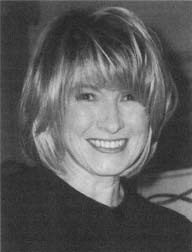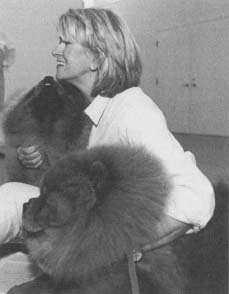Martha Stewart
Born: August 3, 1941
Jersey City, New Jersey
Founder and CEO, Martha Stewart Living
Omnimedia, Inc.

Martha Stewart first offered help to "curious homemakers" with her 1982 book Entertaining. Driven to be rich and famous, Stewart went on to build a media empire based on showing others how to live tastefully and well. She shared her knowledge of food, home decor, gardening, and entertaining with an eager audience. Stewart has defined simple elegance and style for a generation of Americans and a growing number of customers around the world.
Simple Beginnings
Martha Kostyra Stewart was born on August 3, 1941, in Jersey City, New Jersey. She was the second of six children and eldest daughter of Edward and Martha Kostyra. Her grandparents were Polish immigrants. Stewart grew up in Nutley, New Jersey, where her parents lived in a simple middle-class home. As a child, she learned about carpentry and gardening from her father, a salesman. In one of her magazines, Stewart wrote that she also inherited Mr. Kostyra's "fiery temper."
"I always considered myself the ideal [Martha Stewart] customer, the perfect example of the curious homemaker who needs help.… I wanted to be comprehensive, expansive, all encompassing. I wanted to take a subject, not a brand. I took the subject of living."
Stewart showed an early interest in entertaining, sometimes organizing birthday parties for neighborhood children. By her teen years, Stewart developed several other traits that stayed with her as an adult. She rarely slept more than three or fours a night, and she was driven to succeed in everything she did. That perfectionism helped her earn straight A's in high school and acceptance into Barnard, a prestigious women's college in New York City.
To help pay for college, Stewart modeled clothes in department stores and appeared in commercials, continuing work she had begun in high school. Blonde and pretty, she found many modeling jobs, and in 1961 Glamour magazine named her one of the ten best-dressed college women in the United States.
Searching for a Career
Later in 1961, Stewart married Andy Stewart, a law student. (Martha and Andy Stewart divorced in 1990.) She left Barnard to model until her husband graduated. Stewart then returned to Barnard, and in 1964 she received a degree in art history. She kept modeling until the birth of her daughter Alexi in 1965, and for several years Stewart was a mother and homemaker. During that time, she and her husband spent many weekends fixing up a vacation house they bought in western Massachusetts. Stewart had the chance to develop the renovating and gardening skills she would display later on. She also hosted many parties at her home in New York, sharpening her love of cooking and entertaining. A friend from that period said in Just Desserts, "Martha was always a step ahead.… She had an eye for what was good, what was fresh, and what was expressive of that particular moment."
In an interview on 60 Minutes, Stewart recounted that her first high school modeling jobs paid $15 an hour, "which was a lot better than the $1 an hour we were getting babysitting."
By 1968, Stewart was eager to return to full-time work. Through friends, she landed a job as a stockbroker. For the next five years, she excelled in the position, which in a 1991 New York interview she called "the most enthusiastic and daring job I could have." In 1973, however, the U.S. economy slid into a recession, an economic downturn that forced companies to cut jobs and consumers to invest less money. Stewart quit her job, and she and her family moved to an old farmhouse in Westport, Connecticut.
Once again, Stewart spent many hours fixing up a home. In 1976, when the project was complete, Stewart was eager to try another career, this time drawing on her love of food. Out of a kitchen in her basement, Stewart began a catering business. Working with a series of partners, Stewart catered weddings, parties, and other events. As always, she wanted every affair to be perfect, and she sometimes showed her temper when things went wrong.
Stewart finally went into business on her own, running a store called the Market Basket. Located in a mini-mall, the Market Basket sold a variety of gourmet foods and craft items. Stewart was supposed to make the food herself, but instead she hired others to cook for her. A disagreement with the owners at the mini-mall forced Stewart out of the Market Basket, so she opened her own store. Food, she found, was her true calling, and soon Stewart was ready to expand her business.

Living like Martha
Stewart's food business led to assignments writing about food for several magazines. In 1982, it also led to her first book, Entertaining. Not just a cookbook, the book included Stewart's memories of her family and the events that brought her to the catering business. She described cooking for friends while in high school and a 1964 trip to Europe that sparked her curiosity about fine dining. The book sold well, but it also stirred trouble. Several cooks and food writers noticed that Stewart had stolen recipes and passed them off as her own. One of these writers was Barbara Tropp. Tropp told Jerry Oppenheimer she recognized recipes she herself had created and published in magazines. "It was clear to me," she said, "that Martha Stewart had lifted my work without attribution."
The controversy, however, did not seem to bother consumers, who loved Entertaining and Stewart's subsequent books. In 1990, Stewart reached a new audience when she introduced Martha Stewart Living magazine. By then, she had already appeared frequently on television and made an arrangement with Kmart to sell household items with her name on them.
Martha Meets Her Match
Within Martha Stewart Living Omnimedia, Inc, Martha Stewart relies heavily on the skills of company president and chief operating operator (COO) Sharon Patrick. The two met in 1993 while climbing Mt. Kilimanjaro in Africa. Four years later, Patrick led the negotiations that helped Stewart buy Martha Stewart Living from publisher Time Warner. After the sale, a Time official told Business Week, "Without Sharon there would have been no deal." Patrick also played an important role in negotiating a new deal between Stewart and Kmart.
Born in San Diego, Diego, on December 30, 1942, Patrick graduated from Stanford University in 1967 and earned a master's of business administration (MBA) from Harvard. During the 1970s, she worked briefly in the U.S. government before turning to marketing and the media. Patrick and Stewart discussed business as they made their Kilimanjaro climb, and Stewart told Business Week in 1997, "I admired her ability to put everything down in a clear business plan."
Like Stewart, Patrick brings out strong reactions—both positive and negative—from business associates. Critics call her ruthless or a bit of a snob. Patrick responded to those charges in a 1997 Business Week article: " Sure I'm demanding. But so are [business executives] Lou Gerstner and Lee Iacocca. If I were a man, I'd be called a great leader."
As Stewart's company grew, other writers saw they could make money poking fun at her. Humor books such as Is Martha Stuart Living? and Martha Stuart's Better than You at Entertaining focused on her drive for perfection in cooking and decorating. Stewart's attention to detail and desire for homemade items required time and patience that many Americans lacked. Even so, many consumers still dreamed of living as she did.
The Martha Empire
In 1997, Stewart bought Martha Stewart Living from its publisher and combined all her products into a new company, Martha Stewart Living Omnimedia, Inc. She continued expanding the company and giving customers useful information. In 2000, Stewart told Maclean's, "We've built our brand based on our reputation as providers of trusted content." For Stewart, quality also meant making sure every product carrying her name met her standards. In her 2000 interview with Adweek, Stewart said, "I wash the sheets myself. I count the stitches… we care that we're not disappointing anybody."
The growth of her company, however, has forced Stewart to begin giving more responsibility to others. In the beginning, she read every word in every article in her magazines, and she developed a reputation as a hard-driving perfectionist who always had to be in control. Still, she continues at a frantic pace, rising early each weekday morning to exercise before heading to her office. And as Stewart told Business Week in a 2000 interview, "If there is something really bad, I'll step in to fix it."
Someday, Stewart knows, the company may have to go on without her. It is nearly impossible, however, to separate Martha Stewart the business from Martha Stewart the person. As she told Business Week, "I have imbued this company with a tremendous amount of my spirit and artistic philosophy."
Everybody Loves Martha?
Along the way, Martha Stewart has stirred a number of critics. Some make fun of her drive for perfection, and her assumption that people have hours to spend making elaborate holiday decorations or cooking gallons of homemade chicken broth. Others say Stewart promotes materialism—the constant search for expensive goods and style—which tends to make people ignore more important issues in life. On a personal level, Stewart's critics have called her dishonest and mean. As one unnamed former colleague told People in 1999, "She has stepped on a lot of people climbing to the top." jerry Oppenheimer, who wrote the Stewart biography just Desserts, found "feelings about this woman ran high: People either loved her or they hated her."
For More Information
Books
Oppenheimer, Jerry. Martha Stewart: Just Desserts. New York: William Morrow and Company, 1997.
Periodicals
Dugan, 1. Jean. "Someone's in the Kitchen with Martha." Business Week (July 28, 1997).
Hayes, Constance L. "Committee Is Frustrated by Stewart." New York Times (August 12, 2002).
Heim, Sarah J. " MarthaStewart.com ." Adweek Eastern Edition (November 12, 2001): p. 6.
"Martha, Inc." Business Week (January 17, 2000): p. 62.
"Martha Stewart Asked to Be Cleared In June, House Aide Says." New York Times (August 13, 2002).
McMurdy, Deirdre. "A Brand Called Martha." Maclean's (December 4, 2000): p. 49.
O'Neill, Anne-Marie. "Martha's Midas Touch." People Weekly (December13, 1999): p. 219.
Schrage, Michael. "Martha Stewart." Adweek Eastern Edition (February 14, 2000): p. 18.
Wells, Melanie. "Overcooked." Forbes (March 19, 2001): p. 176.
Web Sites
Martha Stewart Living Omnimedia, Inc. [On-line] http://www.marthastewart.com (accessed on August 16, 2002).
Comment about this article, ask questions, or add new information about this topic: